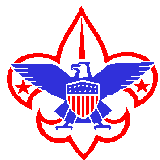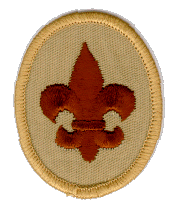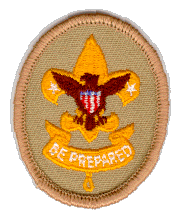

Troop 220
Ranks
To all Scouts, Scouting is a way of life. To most Scouts, Scouting is also their favority sport. As a matter of fact, Scouting is a whole string of sports: camping and backpacking, hiking and orienteering, swimming and canoeing, and much more.
This page show all the requirements that is needed to become an Eagle Scout. Every boy that joins a troop must be at least 11 years old or recieved their "Arrow of Light" or be in the sixth grade.
 Scout
Scout
"Scout" is the first step in your journey to become a boy scout. There are certain requirements that you must meet and complete.
1. Be a boy who has completed the fifth grade or is 11 years old, or has earned the Arrow of Light Award but is under 18 years old.
2. Complete a Boy Scout Application and Health History signed by your parent or guardian.
3. Find a Troop near your home.
4. Repeat the Pledge of Allegiance.
5. Demonstrate the scout sign, salute, and handshake.
6. Demonstrate tying a Square Knot.
7. Understand and agree to live by the Scout Oath or Promise, Law, Motto, and Slogan, and the Outdoor Code.
8. Describe the Scout Badge.
9. Complete the pamphlet exercises in your Boy Scout Handbook.
10. Participate in a Scoutmaster Conference.
 Tenderfoot
Tenderfoot
After completing all the requirements for Scout, you will be working toward this badge. The requirements are as follows:
1. Present yourself to your leader, properly dressed, before going on an overnight camping trip. Show the camping gear you will use. Show the right way to pack and carry it.
2. Spend at least one night on a patrol or troop campout. Sleep in a tent you have helped pitch.
3. On the campout, assist in preparing and cooking one of your patrol's meals. Tell why it is important for each patrol member to share in meal preparation and cleanup, and explain the importance of eating together.
4. Demonstrate how to whip and fuse the ends of a rope. Also, show how to tie and explain the uses of the following knots: two half hitches and the taut-line hitch.
5. Explain the rules of safe hiking, both on the highway and cross-country, during the day and at night. Explain what to do if you are lost.
6. Demonstrate how to display, raise, lower, and fold the American flag.
7. Repeat from memory and explain in your own words the Scout Oath, Law, motto, and slogan.
8. Know your patrol name, give the patrol yell, and describe your patrol flag.
9. Explain why we use the buddy system in scouting.
10. Record your best in the following tests: push-ups, pull-ups, sit-ups, standing long jump, and 1/4-mile walk/run. Also, show improvements in the activities listed after practicing for 30 days.
11. Identify local poisonous plants; tell how to treat for exposure to them.
12. Demonstrate the Heimlich maneuver and tell when it is used. Also, show first aid for the following: simple cuts and scratches, blisters on the hand and foot, minor burns or scalds (first-degree), bites or stings of insects and ticks, poisonous snakebite, nosebleed, frostbite, and sunburn.
13. Participate in a Scoutmaster conference.
14. Complete your board of review.
 Second Class
Second Class
Once you have completed all the requirements for your tenderfoot, you can start working on this badge. The following are the requirements:
1. Demonstrate how a compass works and orient a map. Explain what map symbols mean. Using a compass and map together, take a 5-mile hike.
2. Since joining, have participated in five separate troop/patrol activities, two of which included camping overnight. On one of these campouts, select your patrol site. Also demonstrate proper care, sharpening, and use of the knife, saw, and ax, and use these tools to prepare tinder, kindling, and fuel for cooking fire
3. Participate in a flag ceremony for your school, religious institution, chartered organization, community or troop activity.
4. Participate in an approved service project.
5. Identify or show evidence of at least ten kinds of wild animals.
6. Show what to do for "hurry" cases of stopped breathing, serious bleeding, and internal poisoning. Also, prepare a personal first aid kit. Demonstrate first aid for the following: Object in the eye, bite of a susoected rabid animal, puncture wounds, serious burns, heat exhaustion, shock, heatstroke, dehydration, hypothermia, and hyperventilation.
7. Tell what precautions must be taken for a safe swim. Demonstrate your ability to jump feetfirst into water over your head in depth, level off and swim 25 feet on surface, stop, turn sharply, resume swimming. Demonstrate water rescue methods.
8. Participate in a school, community, or troop program on the dangers of using drugs, alcohol, and tobacco and other practices that could be harmful to your health.
9. Demonstrate Scout spirit by living the Scout Oath and Scout Law.
10. Participate in a Scoutmaster conference.
11. Complete your board of review.
 First Class
First Class
We now at the half way point. The following are the requirements for First Class:
1. Demonstrate how to find directions during the day and at night without using a compass.
2. Using a compass, complete an orienteering course that covers at least one mile and requires measuring the height and/or width of designated items.
3. Since joining, have participated in ten separate troop/patrol activities, three of which includes camping overnight.
4. Help plan a patrol menu for one campout, make a list showing the cost and food amounts needed to feed three or more boys and secure the ingredients. Tell which pans, utensils, and other gear will be needed. On one campout, serve as your patrol's cook.
5. Visit and discuss with a selected individual approved by your leader your Constitutional rights and obligations as a U.S. citizen.
6. Identify or show evidence of at least ten kinds of native plants found in your community.
7. Discuss when you should and should not use lashings. Demonstrate tying the timber hitch and clove hitch and their use in square, shear, and diagonal lashings by joining two or more poles or staves together. Use lashing to make a useful camp gadget.
8. Demonstrate tying the bowline knot and describe several ways it can be used. Demonstrate bandages for a sprained ankle and for injuries on the head, upper arm, and the collarbone. Show how to transport by yourself, and with one other person, a person. Tell the five most common signs of a heart attack. Explain the steps in CPR.
9. Tell what precautions must be taken for a safe trip afloat. Successfully complete the BSA swimmer test. Demonstrate survival skills by leaping into deep water wearing clothes. With a helper and a practice victim, show a line rescue both as tender and as rescuer.
10. Demonstrate Scout spirit by living the Scout Oath and Scout Law.
11. Participate in a Scoutmaster conference.
12. Complete your board of review.
 Star
Star
The requirements for Star Scout are as follows:
1. Be active in your troop and patrol for at least 4 months as a First Class Scout.
2. Demonstrate Scout Spirit by living the Scout Oath and Scout Law.
3. Earn 6 merit badges, including any 4 from the required list for Eagle.
4. While a First Class Scout, take part in service projects totaling at least 6 hours of work. Scoutmaster approval required.
5. While a First Class Scout, serve actively for 4 months in one or more positions of responsibility in your troop.
6. Participate in a Scoutmaster conference.
7. Complete your board of review.
 Life
Life
The requirements for Life Scout are as follows:
1. Be active in your troop and patrol for at least 6 months as a Star Scout.
2. Demonstrate Scout Spirit by living the Scout Oath and Scout Law.
3. Earn 5 more merit badges including any 3 more from the required list for Eagle.
4. While a Star Scout, take part in service projects totaling at least 6 hours of work. Scoutmaster approval required.
5. While a First Class Scout, serve actively for 4 months in one or more positions of responsibility in your troop.
6. Participate in a Scoutmaster conference.
7. Complete your board of review.
 Eagle
Eagle
The requirements for Eagle Scout are as follows:
1. Be active in your troop and patrol for at least 6 months as a Life Scout.
2. Demonstrate Scout Spirit by living the Scout Oath and Scout Law.
3. Earn 21 more merit badges.
4. While a Life Scout, take part in service projects totaling at least 6 hours of work. Scoutmaster approval required.
5. While a Life Scout, plan, develop, and give leadership to others in a service project helpful to any religious institution, any school, or your community.
6. Participate in a Scoutmaster conference.
7. Successfully complete an Eagle Scout board of review.
Return to Home Page
 Scout
Scout
 Tenderfoot
Tenderfoot Second Class
Second Class First Class
First Class Star
Star Life
Life Eagle
Eagle